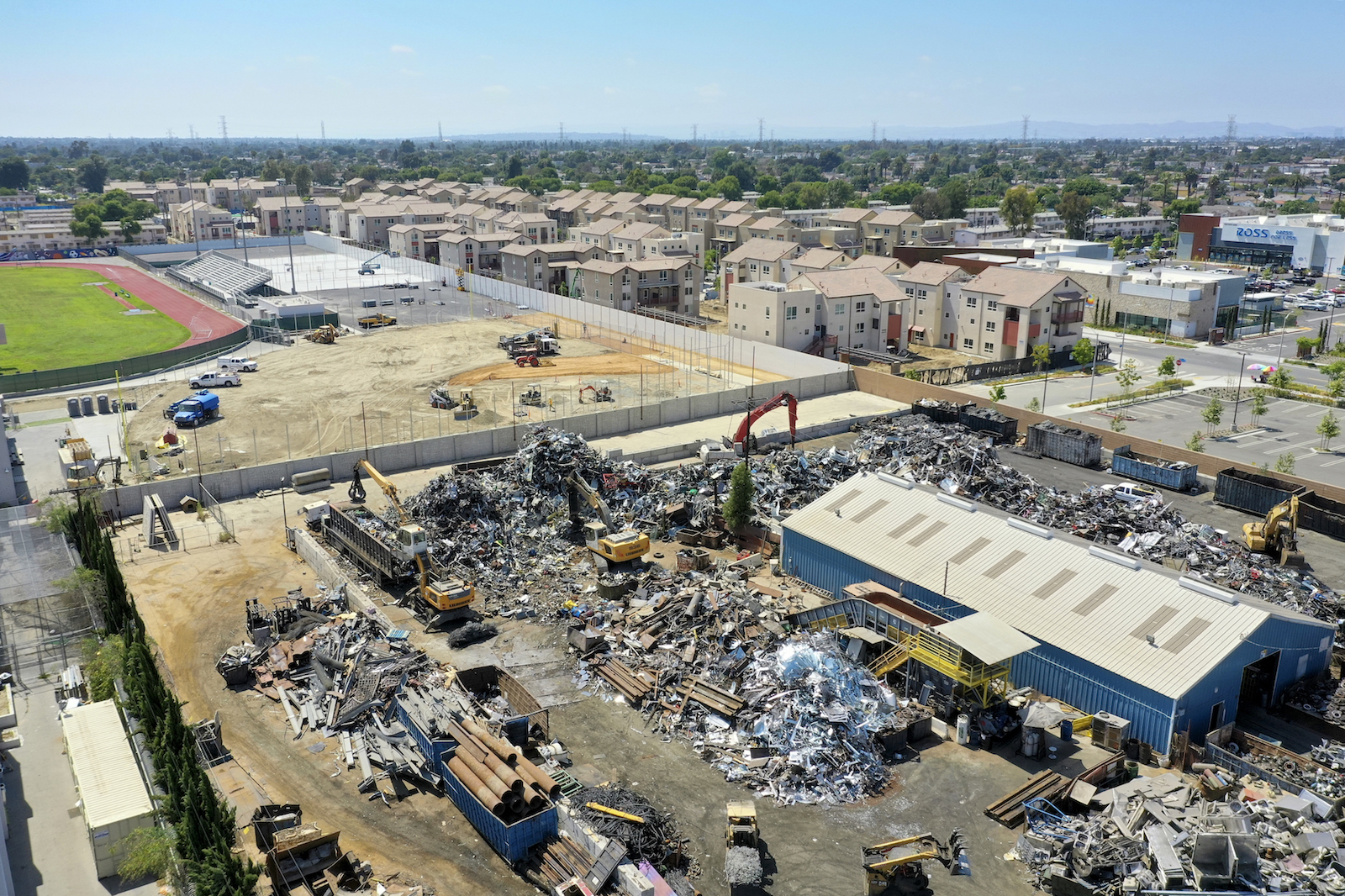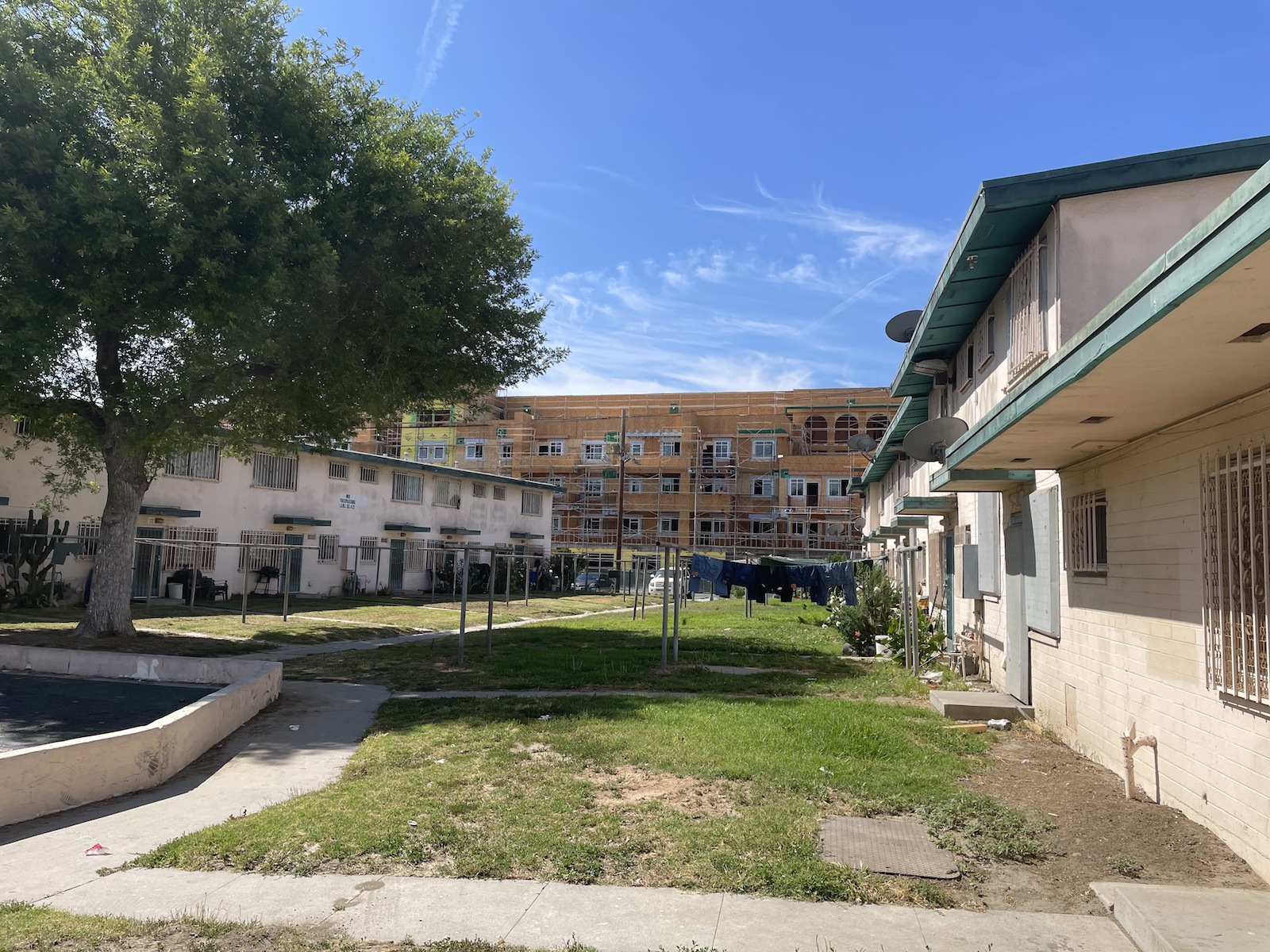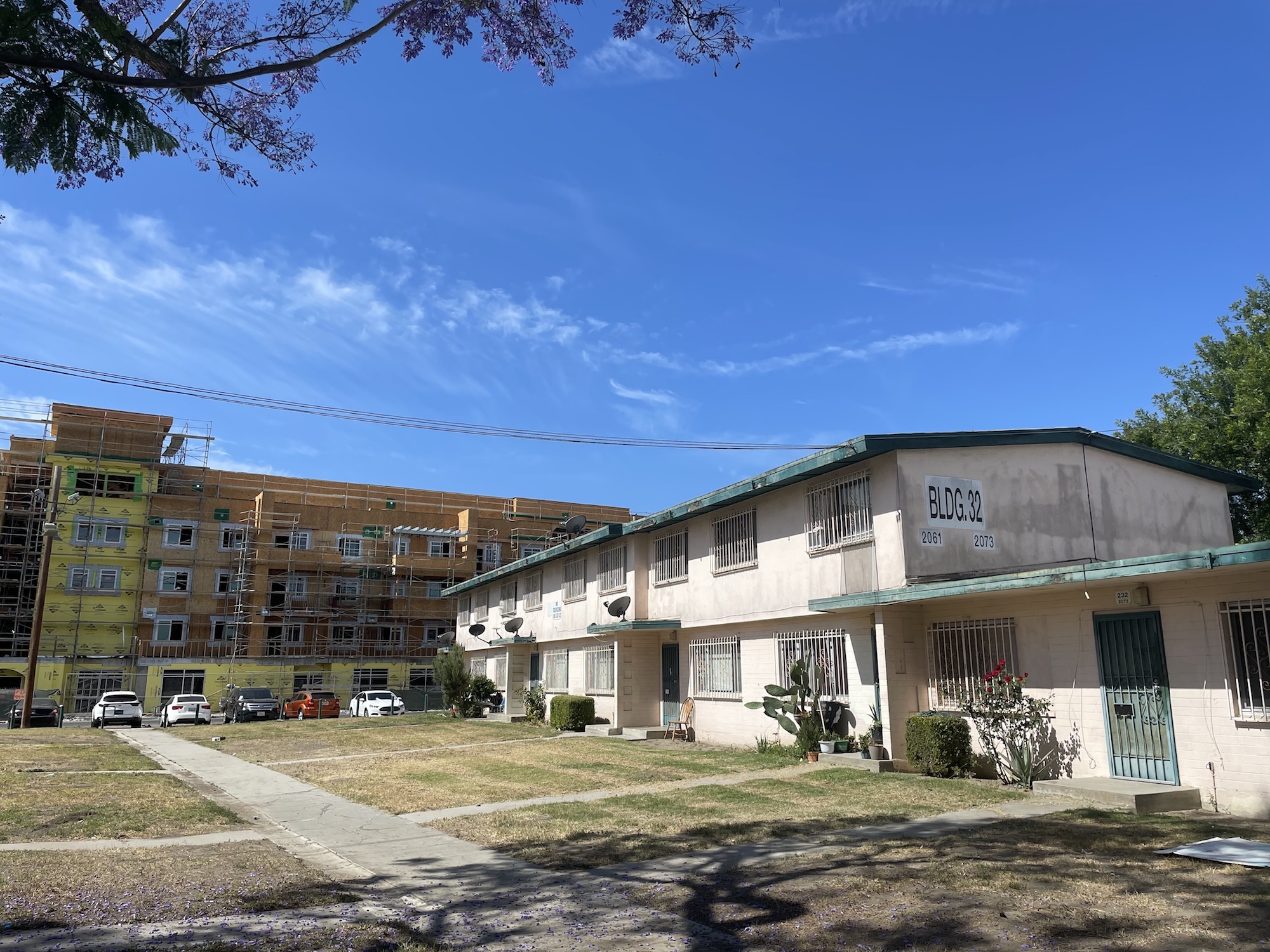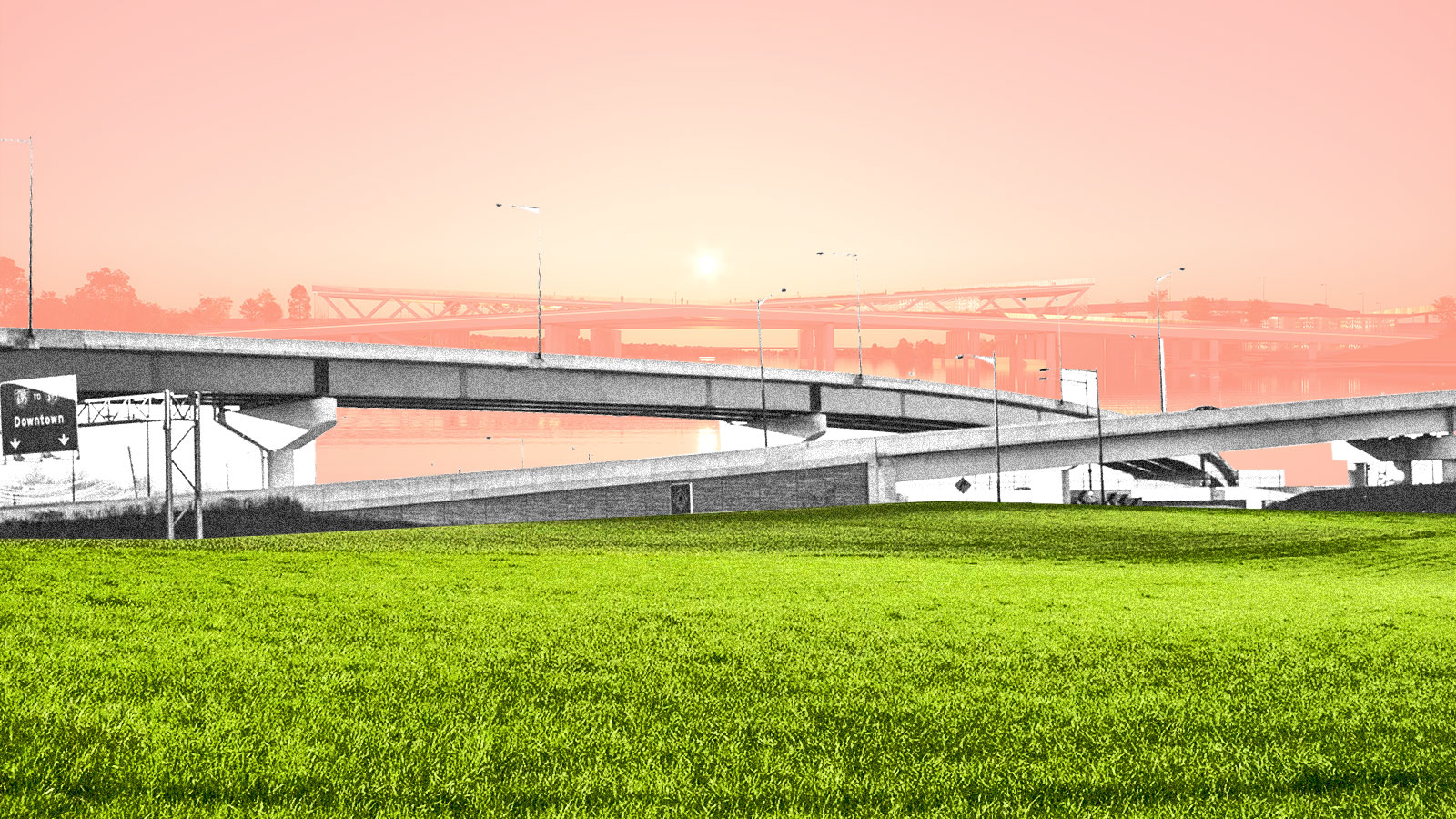Los Angeles’ future is haunted by its past in the South L.A. neighborhood of Watts. A community that has experienced social, economic, and environmental neglect for decades is now the center of the city’s ambitious plans to make housing and transportation more accessible across the increasingly expensive metropolis.
After Watts erupted in massive street protests and riots in 1965, Dr. Martin Luther King declared that the struggle of those living in and around the neighborhood was an “environmental and not racial” problem stemming from “economic deprivation, social isolation, inadequate housing, and general despair.” More than five decades later, those issues persist. The area’s poverty rate has ballooned to 2.5 times higher than the national average, and life expectancy is 10 years shorter than it is in the affluent enclaves of West LA. On top of all that, no other place in California suffers more cumulative environmental burdens, according to the state’s Office of Environmental Health Hazard Assessment.
These perils are exemplified on the corner of Century Boulevard and South Alameda Street. To the east is the Alameda Corridor, a 20-mile long freight rail line leading to the port of Los Angeles, carrying 14,000 trains responsible for thousands of tons of air pollution annually. To the south is Atlas Iron and Metal, a 72-year-old industrial site that is now part of the federal Superfund program to clean up sites of large-scale hazardous contamination. There, 25-foot mounds of shredded metals tower over a wall shared with the local public high school, and sharp metal scraps are known to rain down on students.

Facing west on the same corner is the Jordan Downs housing complex, parts of which sit on the site of a former steel mill. The historically majority-Black public housing site was at the center of both the Watts rebellion and the 1992 L.A. riots. Today the community is 64 percent Latino and 35 percent Black, but it’s once again at the center of a civil rights struggle: the $1 billion redevelopment project meant to revitalize the long-trivialized community.
In theory, the project could be a game-changing investment in the community. More than a decade in the making, the venture has collected funding from the federal and state government and two private companies to turn the Jordan Downs complex into a “mixed-income” community housing more than 700 additional families. It is also introducing much-needed fresh food options (including support for a 2.5-acre urban farm), more green space, the replacement of 65-year-old lead-filled buildings, and increased public transit to different employment hubs across the notoriously car-centric city. On paper, the project appears to fulfill demands Watts residents have been making since 1965.
Nevertheless, given the neighborhood’s deeply entrenched challenges, community groups and residents fear a lose-lose situation: either continuing to live in a toxic corridor if redevelopment does not result in environmental remediation, or else packing up and leaving their lives in Watts behind if successful redevelopment and remediation lead to gentrification and displacement. At the center of their predicament is confusion: They’ve been left to wonder how the most environmentally burdened place in California became one of the most vied-for plots of land in all of LA.
“History shows us that when a housing project gets ‘revitalized,’ it’s never for the community that has called it home for generations,” said Timothy Watkins, a neighborhood resident of 50 years and the president of the Watts Labor Community Action Committee. If history is any indication, Jordan Downs residents have good reason to be distrustful. For decades, they’ve been misled about the safety of their homes and left to live in close proximity to toxic waste and soil contamination. As a result, many don’t trust that redevelopment will solve their problems.
Jordan Downs is one of more than 9,000 federally-subsidized housing properties located within a mile of a Superfund site, according to a recent American Public Media investigation that found the government failed to inform residents of threats stemming from living so close to the country’s most contaminated locales. For years, Jordan Down residents have seen their drinking water come out of the faucet black, brown, and sometimes yellow — they fear lead contamination, though no contamination source has yet been confirmed. Documents released to Grist through California’s Public Records Act show that thousands of square feet of walls, roofs, and railings in the housing complex were found to have levels of lead paint and asbestos requiring toxic remediation last year. The community’s air pollution is worse than 98 percent of the country, according to Environmental Protection Agency data, and its proximity to harmful industrial polluters has been the center of multiple lawsuits from community members, state agencies, and the local school district. Among other things, the suits call for a total remediation project and increased regulation of nearby polluters, especially Atlas Iron and Metal.
“The community is aware of what’s happening: It’s not hard to see that your water is dirty. It’s not hard to know that everyone around you has asthma and high rates of cancer,” said Fatima Iqbal-Zubair, a former environmental science teacher at Watts’ Jordan High School who decided to run for a state assembly seat in part to address these issues. “It’s something people see and they’ve been fighting for — but [they’ve] been put on the back burner by elected officials.”
Before construction was first supposed to begin on the redevelopment project in 2011, California’s Department of Toxic Substances Control, or DTSC, conducted environmental assessments of the site. Tests showed that lead soil contamination around Jordan Downs was at 22,000 parts per million, or ppm — 275 times higher than state limits. The soil also came back with actionable levels of the cancer-causing toxins arsenic, cadmium, and polychlorinated biphenyls. It’s unclear how long city officials knew that the housing complex was contaminated, but in 2009 internal city memos showed that the site “might also suffer from environmental contamination and therefore might require remediation.” Watkins told Grist that his efforts to get local representatives to confront the problem prior to the redevelopment were rebuffed.
After community outrage and activism following the 2011 test results, the city began a roughly five-year cleanup process, removing hundreds of thousands of tons of lead from the soil before concluding it no longer contained “chemicals at concentrations which could pose a risk” to future residents. The process incited controversy: Through a public records request, a local journalist unearthed emails from DTSC that used racist language to denigrate the Jordan Downs community and joked about residents living with toxic waste.

In the years since DTSC claimed no further action was needed, community members like Watkins have taken it upon themselves to test the soil using a crowdsourced X-ray fluorescence machine. According to their data, lead levels around both original housing structures and newly-constructed affordable housing buildings are nearly 100 ppm, far below the 2011 readings but still significantly above the state-approved level of 80 ppm. However, DTSC and the city of Los Angeles have declined to take further action, saying that although some test levels are above state limits, lead levels fall below 80 ppm when samples are averaged across the entire property.
In the meantime, DTSC has removed at least another 1,690 tons of contaminated soil from the area since 2018, and an additional 870 tons have been removed from nearby Jordan High School, according to DTSC’s Hazardous Waste Tracking System.
If contaminated soil is still present at significant levels, the combination of large-scale construction and increasingly hot summers poses an especially acute threat to residents.
“Climate change will make this worse,” said Danielle Hoague, a doctoral student at the UCLA Institute of the Environment and Sustainability and volunteer with the Better Watts Initiative, a neighborhood environmental group. “Kids actually have higher blood lead levels when it’s summer and when it’s hotter, and with the continued construction, there’s more dust kicked up for the folks who’ve been stuck living there.”
Even if the soil is constantly removed and replaced as it has been, advocates are fearful that soil vapor — a process in which underground contaminants infiltrate the air inside buildings located above them — and legacy contamination from a pipeline that once forced a nearby public housing complex to be shuttered makes it impossible to completely rid the ground of toxins. In 2017, DTSC announced that there was no potential risk from any groundwater soil vapor under Jordan Downs. However, to residents’ confusion, the department also claimed that a Vapor Intrusion Mitigation System — a system meant to reduce health risks in buildings where chemical vapors from contaminated soil and groundwater are found — was needed beneath new buildings. (A DTSC official told Grist that “offsite vapor risk” made the mitigation system necessary for some commercial buildings on the property, but that no vapor risk exists in “the area approved for residential use.”)
“The city is avoiding responsibility for full toxic abatement by just redeveloping,” Hoague told Grist. “The idea is that, if they sell the land to developers and go through a cleanup process, no matter how flawed, they rid themselves of responsibility — and also the people who are going to move in there won’t ever have to know what is wrong with the land.”
HACLA insists that it has ensured a thorough cleanup by constantly testing the soil during construction, though it declined to share test results with Grist. If there are any hazardous substances found above state limits, according to the agency, the soil is removed and then retested to make sure toxicity levels are compliant before construction on new buildings begins.
When the redeveloped housing complex is completed, around 700 new families will move in, some through subsidized housing and others paying market value. That’s the source of longtime residents’ other fear, besides inadequate environmental remediation: that changes in the community’s rental structure and an influx of wealthier residents will eventually outprice the most vulnerable community members.

The private backing of the redevelopment project is at the root of this concern. In partnership with the BRIDGE Housing Corporation and The Michaels Organization, the city of Los Angeles first embarked on the billion-dollar plan to redevelop the 700-unit public housing complex into a 1,400-unit “mixed-income” community in 2008. Since 2017, the partners have received more than $70 million in grants from the state and federal agencies such as the Department of Housing and Urban Development, plus more than $100 million in loans from major banks. The project, which first broke ground in 2018, is transforming a majority of the publicly-owned and subsidized housing into housing that is privately-owned — but still publicly subsidized.
Typically, rent prices for public housing residents are fixed at about 30 percent of their personal incomes. However, the new “affordable” units at Jordan Downs will be reserved for households making anywhere between 30 and 80 percent of the area’s median income, and some units won’t have an affordability cap at all. That means an introduction of new residents that are making tens of thousands of dollars more annually than those already living in Jordan Downs — a potentially big problem for low-income renters, if the area’s median income starts to rise.
About a decade ago, L.A.’s current housing authority CEO, Douglas Guthrie, spearheaded a similar process in Chicago. It led to the almost total displacement of a majority-Black public housing complex in favor of “mixed-income” housing.
Jenny Scanlin, chief development officer at the Housing Authority of the City of Los Angeles, or HACLA, told Grist that rent prices in Jordan Downs will not increase for most tenants who will relocate to the new buildings, but some “households might see some increases depending on how many household members cannot be covered by the federal subsidies.”
“We cannot be doing this in Watts,” countered Iqbal-Zubair, the former teacher. “We should be filling the needs of the community already there, not bringing in people who can pay more.”
While the city claims that every Jordan Downs resident will be offered a space in the new development, the affordable housing prices in the new buildings are determined by subsidies that must be renewed every 20 years. That’s set off alarm bells among residents, according to Watkins, because the area’s median income may drastically change in the coming decades. (HACLA says the complex will continue to have “affordable housing” for the entirety of HACLA’s lease of the land, which won’t expire for at least 70 years.)
Despite these concerns, so far only 15 percent of the 182 families offered spots in new units have decided not to stay in the new Jordan Downs complex, according to HACLA. Residents who decide not to stay are given the choice of either moving into one of L.A.’s 13 public housing complexes or taking a Section 8 voucher. The latter is a risky proposition: A 2018 Urban Institute study found that 76 percent of landlords in Los Angeles refuse to accept vouchers, with even more landlords refusing vouchers in areas with low median incomes, like Watts.
In the meantime, Jordan Downs will remain a home to working-class Black and Latino Angelenos, just as it has been for more than half a century. Some help is undoubtedly on the way: When asked if any efforts are being taken by the city to mitigate air, soil, and noise pollution in the new units, HACLA told Grist that “the new units have air conditioning and filtered air systems as well as double-paned windows.” Residents will also have the right “to make reasonable accommodation requests for any health issues they have.”
But people living in Jordan Downs say that requests for help and accommodation can’t get at the root of their problems. “What we’re seeing today in Jordan Downs is systemic racism rearing its head,” said Watkins. Advocates like Watkins are continuing to call for the same things they’ve been fighting for all these years: a total environmental remediation project and a firm guarantee that community members will not be outpriced by new residents.
“The city’s commitment to housing should be more than just shelter,” Watkins said. “It’s about providing the resources — economic, social, and environmental — that establish an opportunity for us to grow.”



